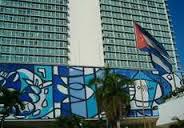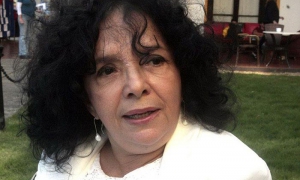
When on January 8, the Rebel Army’s victory caravan entered Havana, at the top of Vedado’s La Rampa an important tourist facility was already being constructed, with an amazing ceramic mural on its façade.
Amelia called her work Las frutas cubanas, composed of 6,700,000 individual tiles (small square pieces of colored glass) on a 69 meter long by 10 meter high surface.The artist restricted herself to a limited color pallet, which included extraordinary selections of white, black, grey and nine tones of blue. Financial problems for the hotel meant that the mural fell in to a certain state of disrepair, however, at the end of 1997, a restoration process began, with cooperation from Mexico. The tiles were remounted on panels of reinforced concrete giving new life to the work.
Aside from these details, Las frutas cubanas, is one of the finest examples of Amelia Peláez del Casal’s work, whose life was commemorated this past January 5, on the 120th anniversary of her birth in the town of Yaguajay in Villa Clara, today located within the province of Sancti Spíritus.
The mural is noteworthy for its depiction of various elements related to the artist’s ideas surrounding identity, developed throughout her career: the spirit, symbolism of tropical fruits and plants and the incorporation of Cuban everyday household items.
Thus a reading of Las frutas cubanas can lead us to conclude that the work is metaphoric and quintessential representation of nature closely related to her personal experience, but also to an understanding of how she fuses these elements with the traditional fences, trellises, and stained glass of the predominant residential architecture of the late colonial period through the early Republic.
Amelia began her artistic training at the San Alejandro Academy, where she received classes from maestro Leopoldo Romañach. She then traveled to Paris where she continued her studies at the Grande Chaumiere Academy, the National Higher School of Fine Arts and Louvre School.
Later during her artistic career, Amelia decided to take up ceramics, which the creator always considered an art, rather than a craft, even in regards to everyday utilitarian objects. In 1950, she began to visit Dr. Rodríguez de la Cruz’s workshop in Santiago de las Vegas and in 1995 opened her own, where she worked until 1962.






